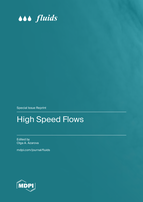High Speed Flows
A special issue of Fluids (ISSN 2311-5521).
Deadline for manuscript submissions: closed (20 November 2022) | Viewed by 31167
Special Issue Editor
Interests: fluid mechanics; computational fluid dynamics; numerical simulation; aerodynamics; flow control; CFD coding
Special Issues, Collections and Topics in MDPI journals
Special Issue Information
Dear Colleagues,
High-speed gas flows occur during the movement of aircrafts, rockets, descent vehicles, as well as in combustion chambers, nozzles and in many other technological applications. High-speed flows are characterized by a complex shock–vortex structure and the presence of large gradients of gas parameters due to the emerging shock waves, areas of shear deformations and the possible development of gas-dynamic instabilities. This Special Issue of Fluids is focused on the recent advances in the numerical and experimental modeling of high-speed flows. The planned topics include (but are not limited to) the following areas: supersonic/hypersonic flows, flow control, shock waves, turbulence, vortices and vortex structures, boundary layers, heat fluxes, gas-dynamic instabilities.
Dr. Olga A. Azarova
Guest Editor
Manuscript Submission Information
Manuscripts should be submitted online at www.mdpi.com by registering and logging in to this website. Once you are registered, click here to go to the submission form. Manuscripts can be submitted until the deadline. All submissions that pass pre-check are peer-reviewed. Accepted papers will be published continuously in the journal (as soon as accepted) and will be listed together on the special issue website. Research articles, review articles as well as short communications are invited. For planned papers, a title and short abstract (about 100 words) can be sent to the Editorial Office for announcement on this website.
Submitted manuscripts should not have been published previously, nor be under consideration for publication elsewhere (except conference proceedings papers). All manuscripts are thoroughly refereed through a single-blind peer-review process. A guide for authors and other relevant information for submission of manuscripts is available on the Instructions for Authors page. Fluids is an international peer-reviewed open access monthly journal published by MDPI.
Please visit the Instructions for Authors page before submitting a manuscript. The Article Processing Charge (APC) for publication in this open access journal is 1800 CHF (Swiss Francs). Submitted papers should be well formatted and use good English. Authors may use MDPI's English editing service prior to publication or during author revisions.
Keywords
- gas flows
- hypersonic flows
- flow control
- shock waves
- turbulence
- vortices and vortex structures
- boundary layers
- heat fluxes






